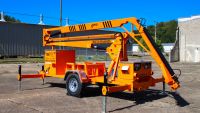November 2, 2011 2:00 PM CDT
RAXTAR and Hydro Mobile have been selected by Atlantic Hoisting and Scaffolding to provide hoists and mast climbing work platforms for use in the rebuilding of One World Trade Center formerly known as the Freedom Tower. The companies have joined forces with New York hoist provider Atlantic Hoisting and Scaffolding to allow transport of men and materials to each floor of the projected 1776-foot structure.
Tishmann Construction turned to Atlantic Hoisting and Scaffolding of New York/New Jersey to provide a full solution for its logistics concern of moving more than 1,300 men, women, tools and materials daily to build the tower. A long list of concerns was developed and applied to the selection of equipment to be used. Among many, a primary concern was that no Chinese content be used in any component of the hoists. A non-counterweighted design also topped the list as it related to safety and speed of erecting, since this was to be a fast-track project. As the plans unfolded, dependability was key.
Atlantic Hoisting and Scaffolding’s team, led by Greg Karas, addressed the the idea of "the common tower." This is a structure typically made from a four-pole configuration of shoring, and scaffolding components decked at each entry level, to allow exit of the hoists and access to the building under construction, minimizing the interference with the curtain wall installation. It allows the building to be closed in earlier than in conventional configurations of the Hoists. In the case of One World Trade Center, the extreme height and concern for workers safety were bringing an additional challenge to the traditional conception of the common tower.
Atlantic Hoisting and Scaffolding’s team decided to abandon the conventional four-pole components generally used for the common tower, in lieu of actual Rack and Pinion tower sections at the four corners, giving them a means for adapting mechanical access equipment to perform the construction of the platform in a safe and efficient way. Atlantic Hoisting and Scaffolding's Todd Rego says he has reduced his labor during the construction process by 30 percent, and finds the safety factor increased by an immeasurable amount. The common tower is, in all reality, a temporary building built alongside the permanent structure. It has wind load, capacity requirements per floor and a fast tracked construction timeline, much like the property under construction.
Thirteen RAXTAR Model RX3245 hoists have been placed throughout the two side-by-side projects. RAXTAR was open and receptive to the specific requests of Atlantic Hoisting and Scaffolding, and their ideas to ensure a safe, productive artery to the project. Multiple RX3245SFT, 300 feet per minute, 7,000-lb. men and material hoists were designed with an overhead protection deck above the car for installer’s protection from workers above them. The cars incorporated designs from the years of combined experience of Atlantic Hoisting and Scaffolding and RAXTAR engineers. A structural “common tower platform” is an integral part of the configuration of the hoisting areas. A custom work platform designed specifically for the construction of the common tower structure was built by Hydro-Mobile and is in constant use as the project climbs at a pace of one floor per week. Since its installation in November 2009, the hoists run six days per week, moving 1300 to 1400 men and women to all the stops on its way to an overall height of 1776 feet, where the top floor will be denoted as the 82nd Floor.
It is expected that three additional years of use should be required before the project is completed. For more information, visit www.hydro-mobile.com.
Hoisting at One World Trade Center
RAXTAR, Hydro Mobile to provide equipment
By Masonry

RAXTAR and Hydro Mobile will provide equipment for the rebuilding of One World Trade Center.
RAXTAR and Hydro Mobile have been selected by Atlantic Hoisting and Scaffolding to provide hoists and mast climbing work platforms for use in the rebuilding of One World Trade Center formerly known as the Freedom Tower. The companies have joined forces with New York hoist provider Atlantic Hoisting and Scaffolding to allow transport of men and materials to each floor of the projected 1776-foot structure.
Tishmann Construction turned to Atlantic Hoisting and Scaffolding of New York/New Jersey to provide a full solution for its logistics concern of moving more than 1,300 men, women, tools and materials daily to build the tower. A long list of concerns was developed and applied to the selection of equipment to be used. Among many, a primary concern was that no Chinese content be used in any component of the hoists. A non-counterweighted design also topped the list as it related to safety and speed of erecting, since this was to be a fast-track project. As the plans unfolded, dependability was key.
Atlantic Hoisting and Scaffolding’s team, led by Greg Karas, addressed the the idea of "the common tower." This is a structure typically made from a four-pole configuration of shoring, and scaffolding components decked at each entry level, to allow exit of the hoists and access to the building under construction, minimizing the interference with the curtain wall installation. It allows the building to be closed in earlier than in conventional configurations of the Hoists. In the case of One World Trade Center, the extreme height and concern for workers safety were bringing an additional challenge to the traditional conception of the common tower.
Atlantic Hoisting and Scaffolding’s team decided to abandon the conventional four-pole components generally used for the common tower, in lieu of actual Rack and Pinion tower sections at the four corners, giving them a means for adapting mechanical access equipment to perform the construction of the platform in a safe and efficient way. Atlantic Hoisting and Scaffolding's Todd Rego says he has reduced his labor during the construction process by 30 percent, and finds the safety factor increased by an immeasurable amount. The common tower is, in all reality, a temporary building built alongside the permanent structure. It has wind load, capacity requirements per floor and a fast tracked construction timeline, much like the property under construction.
Thirteen RAXTAR Model RX3245 hoists have been placed throughout the two side-by-side projects. RAXTAR was open and receptive to the specific requests of Atlantic Hoisting and Scaffolding, and their ideas to ensure a safe, productive artery to the project. Multiple RX3245SFT, 300 feet per minute, 7,000-lb. men and material hoists were designed with an overhead protection deck above the car for installer’s protection from workers above them. The cars incorporated designs from the years of combined experience of Atlantic Hoisting and Scaffolding and RAXTAR engineers. A structural “common tower platform” is an integral part of the configuration of the hoisting areas. A custom work platform designed specifically for the construction of the common tower structure was built by Hydro-Mobile and is in constant use as the project climbs at a pace of one floor per week. Since its installation in November 2009, the hoists run six days per week, moving 1300 to 1400 men and women to all the stops on its way to an overall height of 1776 feet, where the top floor will be denoted as the 82nd Floor.
It is expected that three additional years of use should be required before the project is completed. For more information, visit www.hydro-mobile.com.
About the Author
Masonry, the official publication of the Mason Contractors Association of America, covers every aspect of the mason contractor profession - equipment and techniques, building codes and standards, business planning, promoting your business, legal issues and more. Read or subscribe to Masonry magazine at www.masonrymagazine.com.


















